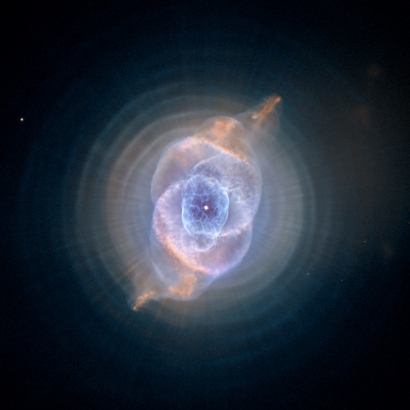Cat's Eye Nebula in Stunning Detail [heic0414]
9 September 2004
A new study of a large number of planetary nebulae has revealed that rings, such as those seen here around the Cat's Eye Nebula, are much more common than thought so far and have been found in at least one third of all planetary nebulae. Although the rings may be the key to explaining the final 'gasp' of the dying central star, the mystery behind the Cat's Eye Nebula's nested 'Russian doll' structure remains largely unsolved.
 |
The Cat's Eye Nebula, formally catalogued as NGC 6543 and seen here in this detailed view from the NASA/ESA Hubble Space Telescope, is one of the most complex planetary nebulae ever seen in space. A planetary nebula forms when Sun-like stars gently eject their outer gaseous layers to form bright nebulae with amazing twisted shapes. Hubble first revealed NGC 6543's surprisingly intricate structures including concentric gas shells, jets of high-speed gas and unusual shock-induced knots of gas in 1994.
This new image, taken with Hubble's Advanced Camera for Surveys (ACS), reveals the full beauty of a bull's-eye pattern of eleven or more concentric rings, or shells, around the Cat's Eye. Each 'ring' is actually the edge of a spherical bubble seen projected onto the sky - which is why it appears bright along its outer edge.
Observations suggest that the star ejected its mass in a series of pulses at 1500-year intervals. These convulsions created dust shells that each contains as much mass as all of the planets in our Solar System combined (but still only one-percent of the Sun's mass). These concentric shells make a layered onion-skin structure around the dying star. The view from Hubble is like seeing an onion cut in half, where each layer of skin is discernible.
Until recently, it was thought that shells around planetary nebulae were a rare phenomenon. However, Romano Corradi (Isaac Newton Group of Telescopes, Spain) and collaborators, in a paper published in the European journal Astronomy & Astrophysics in April 2004, have instead shown that the formation of these rings is likely to be the rule rather than the exception.
The bull's-eye patterns seen around planetary nebulae come as a surprise to astronomers because they had no expectation of episodes of mass loss at the end of stellar lives that repeat every 1500 years or so. Several explanations have been proposed, including cycles of magnetic activity somewhat similar to our own Sun's sunspot cycle, the action of companion stars orbiting around the dying star, and stellar pulsations. Another school of thought is that the material is ejected smoothly from the star, and the rings are created later on due to formation of waves in the outflowing material. It will take further observations and more theoretical studies to decide between these and other possible explanations.
Approximately 1000 years ago the pattern of mass loss suddenly changed, and the Cat's Eye Nebula itself started forming inside the dusty shells. It has been expanding ever since, as can be seen by comparing Hubble images taken in 1994, 1997, 2000 and 2002. But what has caused this dramatic change? Many aspects of the process that leads a star to lose its gaseous envelope are poorly known, and the study of planetary nebulae is one of the few ways to recover information about the last few thousand years in the life of a Sun-like star.
# # #
Notes for editors
The group of astronomers involved in the April 2004, Astronomy & Astrophysics paper are: R.L.M. Corradi (Isaac Newton Group of Telescopes, Spain), P. Sanchez-Blazquez (Universidad Complutense, Spain), G. Mellema (Foundation for Research in Astronomy, The Netherlands), C. Giammanco (Instituto de Astrofisica de Canarias, Spain) and H.E. Schwarz (Cerro Tololo Inter-American Observatory, Chile).
The Hubble Space Telescope is a project of international cooperation between ESA and NASA.
Acknowledgment: R. Corradi (Isaac Newton Group of Telescopes, Spain) and Z. Tsvetanov (NASA).
Contacts
Romano Corradi
Isaac Newton Group of Telescopes, La Palma, Spain
Tel: +34-922-425461
Cellular: +34-626-485736
E-mail: rcorradi ing.iac.es
ing.iac.es
Lars Lindberg Christensen
Hubble European Space Agency Information Centre, Garching, Germany
Tel: +49-89-3200-6306 (089 within Germany)
Cellular: +49-173-3872-621 (0173 within Germany)
E-mail: lars eso.org
eso.org
Keith Noll
Hubble Heritage Team, Space Telescope Science Institute, Baltimore, USA
Tel: +1-410-338-1828
E-mail: noll stsci.edu
stsci.edu

